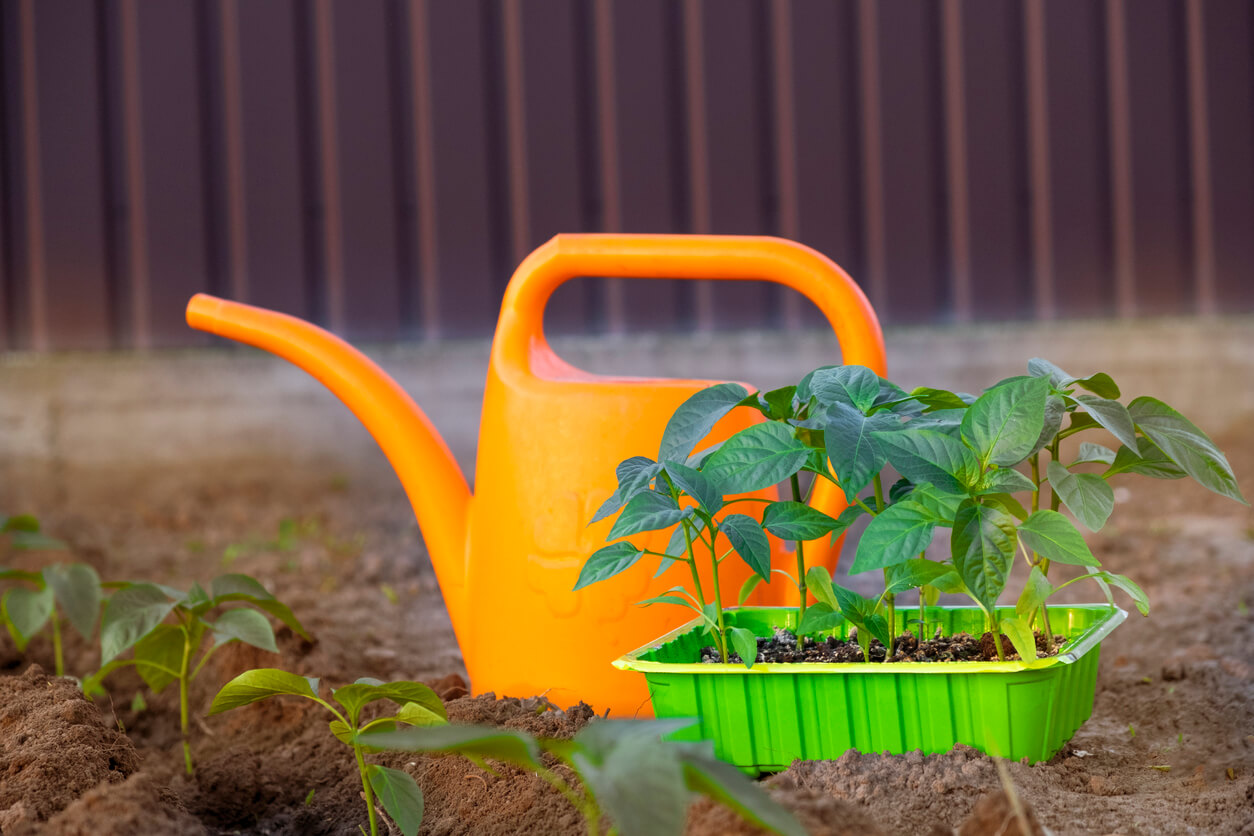
Young chile pepper seedlings next to a watering can
Water
Once your hot peppers are settled in—whether it’s in a container, a raised bed, or open ground—consistency is key when it comes to watering. If you don’t get rain on a regular basis, go out and give your hot peppers a good drink of water. Hot peppers like 1 to 2 inches of water a week. Hot pepper plants hate having wet feet. So the gardening rule of thumb here is: when in doubt, don’t water.
In general, you’ll want to water deeply about once a week, so your plants get about 1 to 2 inches of water. If the top of the soil is a little dry, that’s OK. But don’t let the soil dry out more than an inch down; then it’s time to water. Lay down a layer of mulch to help retain moisture; ground-up leaves, clean grass clippings (no pesticides), or compost work well. You can also use landscape fabric, old newspapers, or straw.
It’s always best to water in the morning, so your plants can soak up the water and put it to work. Watering earlier in the day also gives the sun time to burn off any water on the leaves. When you do water, aim for the base of the plant. Try not to get the leaves wet (unless you’re blasting off pests); that can open the plant to fungal infection.
Weeding
If you’ve planted in raised beds or containers, weeds shouldn’t be much of a problem. If you do see weeds, pull them early and often—but be gentle about it. Loosen the soil gently around your plants, especially when they’re young, so you don’t disturb their roots. For raised beds and containers, this is another good reason to get yourself some fresh garden soil; it’s one less piece of aggravation to deal with during the growing season.
Even if you’re growing your hot peppers directly in the ground, properly preparing your soil is still an excellent preventive measure against the emergence of weeds. When you till or cultivate the area where you’ll plant your hot peppers, remove weeds and debris. You’ll likely find that the first few weeks after planting are the only time you’ll be pulling up weeds around your plants. Of course, there’s nothing to say you can’t amend your garden bed with a little commercially available garden soil. Give your hot peppers all the advantages you can to ensure a healthy crop.
The best strategy for reducing weeds is a by-product of your preparation to ensure your hot peppers have consistent water: mulch. Lay down landscape fabric, newspapers weighted down with rocks or bricks, or a deep layer of mulch, like straw or dried grass clippings.
If weeds spring up around your hot peppers during the growing season, work the soil around the base of the plants with a hand rake—only deep enough to kill the weeds and not damage the plant’s roots.
Fertilizer
If you already have healthy, nutrient-rich soil, you shouldn’t need fertilizer. If you’ve had your soil tested, you have a detailed breakdown of your soil composition, along with recommendations for any necessary amendments. It’s a good idea to prepare your soil by working in some composted manure (never fresh!) down to a level of a few inches.
Don’t go overboard on fertilizing your hot pepper plants. Too much nitrogen can spur a lot of foliage growth but can delay flowering and fruiting of the plants. When your plants are newly transplanted, use a seaweed solution (available at garden centers or through gardening websites) once a week for three weeks, and then monthly. Seaweed fertilizer is packed with micronutrients for your plants, and it will help the plants deal with typical garden stresses like heat, drought, and insects.
You can also side-dress your plants with low-nitrogen organic granular fertilizer (like a 5-10-10 NPK), laying down about 4 tablespoons per plant at the dripline once a month after you transplant them. Granular organic fertilizer is especially helpful for container plants, which have limited soil resources.
How often do you have to fertilize, weed, or water your hot peppers? Do you have any particular challenges growing hot peppers? Please tell us your tips for nurturing healthy hot pepper plants.


 Previous
Previous

